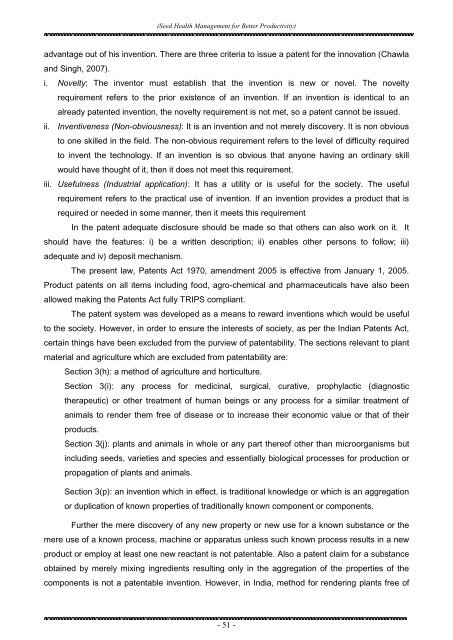Seed Health Management for Better Productivity - Govind Ballabh ...
Seed Health Management for Better Productivity - Govind Ballabh ...
Seed Health Management for Better Productivity - Govind Ballabh ...
Create successful ePaper yourself
Turn your PDF publications into a flip-book with our unique Google optimized e-Paper software.
(<strong>Seed</strong> <strong>Health</strong> <strong>Management</strong> <strong>for</strong> <strong>Better</strong> <strong>Productivity</strong>)advantage out of his invention. There are three criteria to issue a patent <strong>for</strong> the innovation (Chawlaand Singh, 2007).i. Novelty: The inventor must establish that the invention is new or novel. The noveltyrequirement refers to the prior existence of an invention. If an invention is identical to analready patented invention, the novelty requirement is not met, so a patent cannot be issued.ii. Inventiveness (Non-obviousness): It is an invention and not merely discovery. It is non obviousto one skilled in the field. The non-obvious requirement refers to the level of difficulty requiredto invent the technology. If an invention is so obvious that anyone having an ordinary skillwould have thought of it, then it does not meet this requirement.iii. Usefulness (Industrial application): It has a utility or is useful <strong>for</strong> the society. The usefulrequirement refers to the practical use of invention. If an invention provides a product that isrequired or needed in some manner, then it meets this requirementIn the patent adequate disclosure should be made so that others can also work on it. Itshould have the features: i) be a written description; ii) enables other persons to follow; iii)adequate and iv) deposit mechanism.The present law, Patents Act 1970, amendment 2005 is effective from January 1, 2005.Product patents on all items including food, agro-chemical and pharmaceuticals have also beenallowed making the Patents Act fully TRIPS compliant.The patent system was developed as a means to reward inventions which would be usefulto the society. However, in order to ensure the interests of society, as per the Indian Patents Act,certain things have been excluded from the purview of patentability. The sections relevant to plantmaterial and agriculture which are excluded from patentability are:Section 3(h): a method of agriculture and horticulture.Section 3(i): any process <strong>for</strong> medicinal, surgical, curative, prophylactic (diagnostictherapeutic) or other treatment of human beings or any process <strong>for</strong> a similar treatment ofanimals to render them free of disease or to increase their economic value or that of theirproducts.Section 3(j): plants and animals in whole or any part thereof other than microorganisms butincluding seeds, varieties and species and essentially biological processes <strong>for</strong> production orpropagation of plants and animals.Section 3(p): an invention which in effect, is traditional knowledge or which is an aggregationor duplication of known properties of traditionally known component or components.Further the mere discovery of any new property or new use <strong>for</strong> a known substance or themere use of a known process, machine or apparatus unless such known process results in a newproduct or employ at least one new reactant is not patentable. Also a patent claim <strong>for</strong> a substanceobtained by merely mixing ingredients resulting only in the aggregation of the properties of thecomponents is not a patentable invention. However, in India, method <strong>for</strong> rendering plants free of- 51 -
















